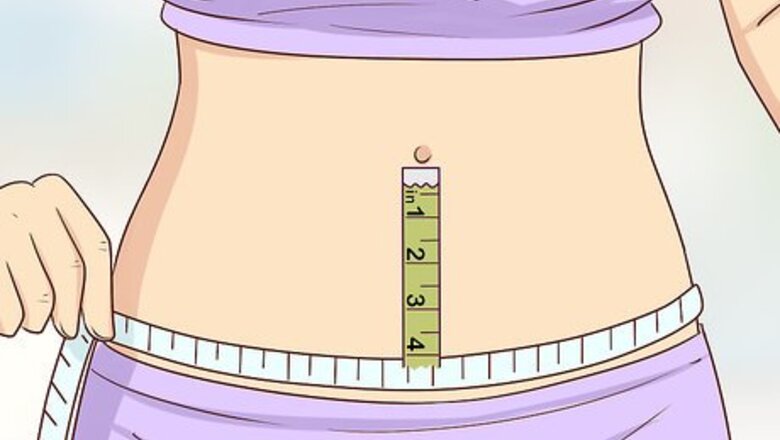
views
Measuring Your Body to Find the Perfect Fit
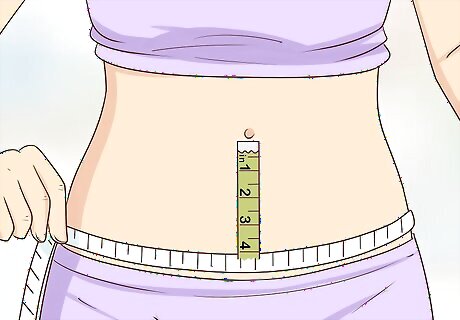
Measure your waist with a soft tape measure. The tape measure has to bend around your waist, so it needs to be soft. Place the measuring tape directly against your skin about 4 inches (10 cm) below your belly button. Pull the tape around your back and circle back to the front to measure your waist. Many stores use this measurement, so keep track of your measurements on a piece of paper. If you’re not measuring against your skin, you won’t get an accurate measurement Your natural waist is actually a bit higher, just slightly above your belly button. However, most jeans sit lower, so you won’t necessarily have to measure there.
Find your inseam by measuring your leg length from the crotch down. With your legs shoulder-width apart, measure the distance from your foot to your crotch on the inside of your leg, starting from where you’d like your jeans to fall on your foot or ankle. If necessary, ask someone you trust to help you get an accurate length. You’ll see this measurement often, especially in men’s sizes. For instance, if you like your jeans a bit long, measure to the bottom of your foot. Try not to bend to read the measurement. If you don’t have someone to help you, use a mirror or mark the measurement with the finger holding the measuring tape. If you’re struggling to hold the measuring tape in place, try using adhesive tape to secure one end to your ankle while you hold the other at your crotch.
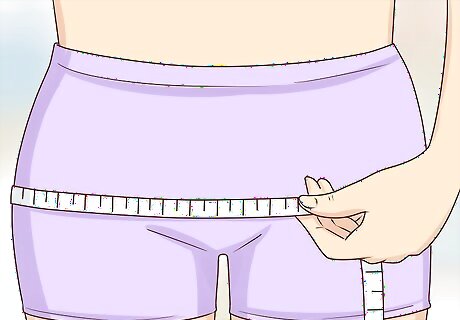
Wrap the tape measure around the widest part of your hips. Some jeans will also have a hip measurement. To find yours, make sure the tape measure isn’t lifting or drooping in the back as you wrap it around your hips. You won’t see this measurement as often, but you can still use it if you’re measuring jeans before trying them on.
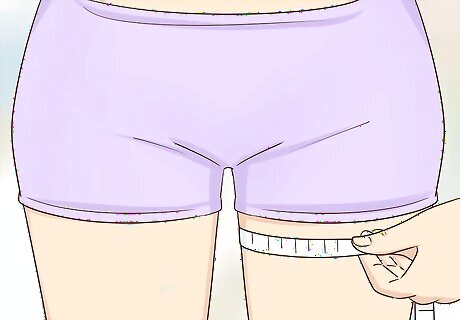
Wrap the tape measure around the thickest part of your thigh. You’ll only need to measure one thigh to get your thigh measurement. If one is slightly thicker than the other, take the measurement for that thigh. Try not to pull the tape too tight or you’ll get an inaccurate measurement; the tape should be snug, but you should be able to slip one finger underneath. This measurement is not very common in jeans, but it can still be helpful to know.
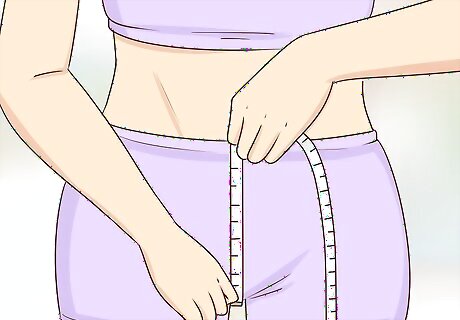
Measure your front rise from your crotch to your belly button. Stretch a tape measure from just behind your crotch line up and over the front of your pelvis to your waist. For women, this is around the belly button; for men, usually an inch or two or a couple centimeters below. It can be helpful to wear a belt for the front rise measurement to give yourself an indication of where your jean waist would lie. You won’t see this measurement as much, but sometimes stores use it to define how high or low the jeans sit. If you need to measure the back rise, do the same thing going the opposite direction.
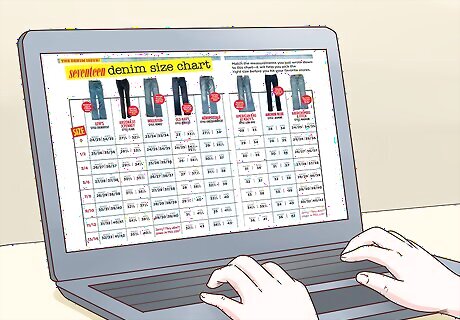
Plug your measurements into a size chart to find a pair of jeans. In women’s jeans, the waist measurement will usually be the best indicator of size, though you may also use the inseam measurement. For men, use both the length and waist measurement when looking at a size chart. Note that sizes may run a little small or large, so it’s always best to check the actual chart. When shopping online, use the brand’s size chart to find the best fit for that particular brand. If you need to see sizes in different brands, check out this chart.
Measuring a Pair of Jeans
Double the size of the waistband to get the waist measurement. To get accurate measurements, lay the jeans on a flat surface and smooth them out. Run a tape measure across the top of the jeans, and make sure the waist isn’t drooping or sagging at all. The waist measurement is one of the most common measurements you’ll see in a store. Wrinkles can throw off your measurements, so make sure your jeans are as smooth as possible before measuring. Button and zip them up beforehand, as well. If your waistband is made from elastic material, don’t stretch it as you measure or you will get an inaccurate measurement. Make note of whether the jeans are labeled as “high-waisted” or “low rise.” If the jeans are intended to sit somewhere other than your natural waistline, you need to know that before buying a new pair.
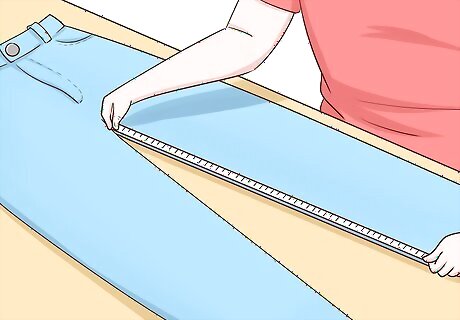
Measure the leg length to find the inseam. The inseam is from the crotch seam down to the hem of the jeans; do not measure from the waist. Make sure the jeans are completely flat when taking this measurement. The inseam is typically used to measure length for pants and is often used by stores to help you find your size, especially for men’s jeans.
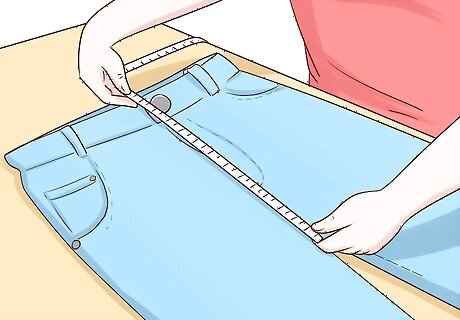
Measure from the crotch to the waist to find the rise. The rise determines where your jeans sit on your waist. Some pant sizes may offer a “front rise” and “back rise” measurement. The front rise is from the crotch to the waistband in front, and the back rise is from the crotch to the waistband in the back. Make note of both of these measurements. It isn’t as common to see this measurement as it is to see waist or inseam measurements, but you may need it sometimes.
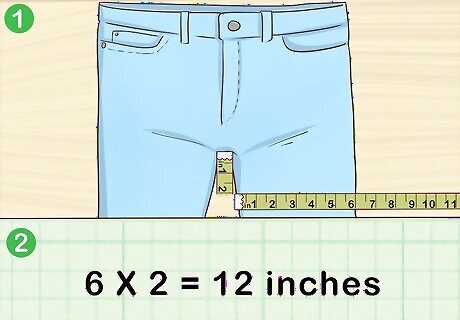
Measure 2 in (5.1 cm) below the crotch seam to get the thigh thickness. Measure horizontally across one leg of the jeans. Then, double the number to get your thigh measurement. It’s unnecessary to measure both legs, as they should be the same size. This measurement also isn’t very common when shopping for jeans, but it will be helpful on occasions.
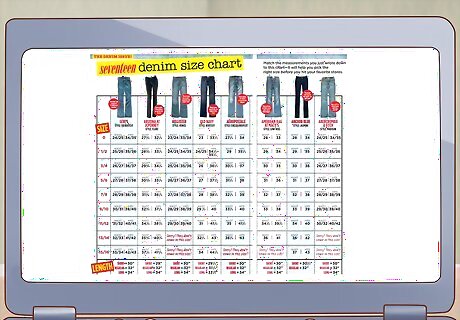
Compare these measurements to a size chart to find your size. For women’s jeans, the waist size will be the most important factor, though the inseam can determine whether you have a tall, regular, or petite pair of jeans. Men’s jeans include both the waist measurement and the length. Plug the measurements you took of your jeans into a size chart to determine the correct size for you. Most shopping websites have size charts for their products, so if you’re looking for a particular brand, use their size chart to get the most accurate measurements. Keep in mind that with men’s jeans you may need to go up a few inches or centimeters in size. Many clothing manufacturers have intentionally made sizes smaller, a problem known as vanity sizing.
Finding a Pair of Jeans that Fit

Factor your preferred rise height into your waist measurement. A low-rise jean will sit 2 to 4 inches (5.1 to 10.2 cm) below your belly button. Mid-rise jeans fall just below your belly button, while high-rise sit closer to the natural waist, at your belly button or a bit above. If you need to, take a waist measurement where you prefer your jeans to fall.

Measure jeans in the store before you try them on. If you hate trying jeans on, use a tape measure to check out the jeans first. Match them up to your measurements to help you find pairs that will fit. If you can’t find a perfect match, choose jeans that are slightly bigger. You could also bring a pair of jeans that fit well to the store with you. Hold them up against new pairs to find one that will fit well.
Try jeans on before buying to see if the measurements are correct. Even if you measure your jeans, it’s still a good idea to try new ones on before you buy them. With your measurements handy, you likely won’t have to try on as many pairs, so the process will go faster than it would otherwise. Each pair of jeans will feel a little bit different, especially if some have stretch in them and others do not. Even if you know they’ll fit, trying them on helps you know if they’ll be comfortable. Bring someone with you when you try on jeans and have them check how they fit from behind since it may be difficult for you to see on your own.
When buying online, study size charts and descriptions to find your size. Most online stores have size charts where you can check out exactly what each of their sizes mean. Plus, many stores will also have size descriptions on the product page, which may include the hip measurement and front rise measurement, so you can get a clearer idea of what you’re buying. Always be aware of vanity sizing, as you may not be the same size at every store. Don’t worry so much about the “correct” size and instead focus on finding the right measurements. That holds true for men’s sizes, too, which are measured in theory but can also fall prey to being different sizes across stores. If you’re shopping for jeans online, read customer feedback and reviews to get a sense for how the pants fit, like if they run large or small. Consider buying from retailers with generous return policies for online sales so you can trade them in for another pair if you need to.
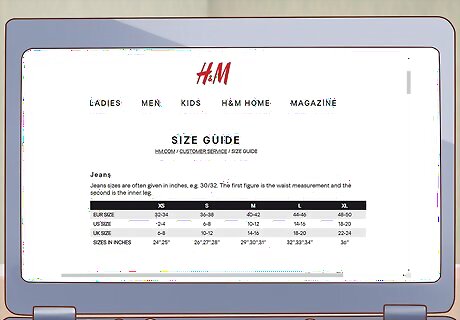
Learn which brands fit you well so you don’t need to measure as often. Some brands will always run smaller or larger, so it’s often helpful to take note of what brands fit you best. Make note, too, of which brands run true to size and which ones don’t. This way, you have a quick reference the next time you’re shopping for jeans. For instance, one site ranked these brands on a scale with the first being the closest to true size and the last being much larger than true size: H&M, Calvin Klein, Alfani, Gap, Haggar, Dockers, Old Navy.
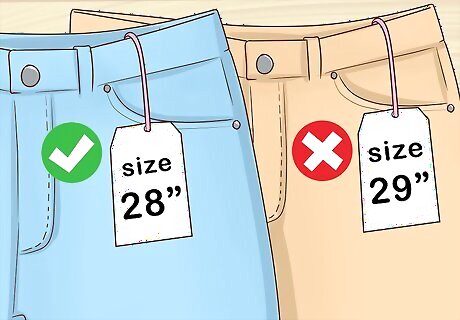
Buy jeans slightly smaller if you think they will stretch. Unless they shrink in the wash, most pairs of jeans are at their tightest the first time you wear them. With the stress from repeated wearing, most jeans loosen up slightly over time, becoming more comfortable to wear. If a pair of jeans feels just a bit too tight when you try them on, you may be able to get away with wearing them in the long run.
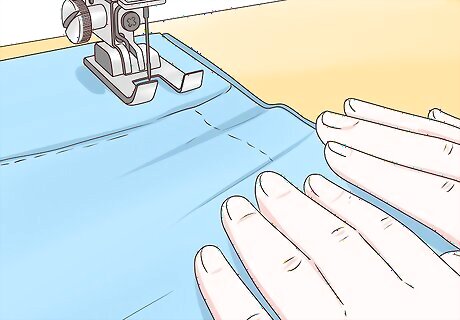
Consider having your pants tailored for a better fit. If you’re not happy with the fit of your jeans, having them tailored can make them fit perfectly, as they can be adjusted to your specific measurements. Tailoring often costs less than buying a bespoke pair of jeans, so find a nearby tailor who can make some adjustments.













Comments
0 comment